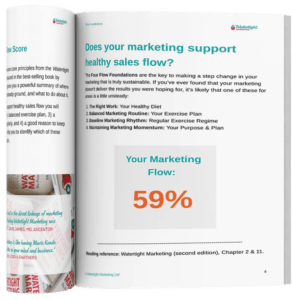At a recent client workshop we worked on a key issue that people knew of them, but for something they now only do a little of. The mental filing in the collective minds of the market was out of date. Certified Practitioner, Peter Baynes, joined me in that session, so I asked him to summarise the key points we covered to get this client back on track. ~ Bryony Thomas, Author – Watertight Marketing
Do people know what you do? You would hope so, but if you are most like companies, the likely answer is that your customers and prospects know of some of what you do. And, many will have a slightly different view on why you do it and what benefits you deliver.
Why is this important? To have a sustainable and profitable business, you need to be attracting the right type of work for your business. And getting the right type of work starts with being known for it.
Are you getting the right type of work?
The right type of work ideally means that you are good at it, enjoy doing it, and it generates you a profit. Of course, this type of business is not always easy to get and, as you build a business up, you can find that you take on customers and work that is less profitable than you would like, and sometimes not what you really like doing or want to be known for. Or, if you provide a range of complementary services or products, you can find that you are only getting customers for a certain product or business line and struggle to up-sell customers to other higher value offerings. (See: What are the Four Foundation Leaks?)
For example, you could be an IT services company that provides a range of product and services but find yourself acquiring customers who are just buying a few software licences, rather than complete IT solutions and support package. Or a print management company, great at fulfilling large and complex print requirements, taking on small orders of simple A4 fliers and business cards.
If you are not careful, you can end up with a business doing things that you are not really good at, don’t enjoy, and at worst, that do not make us money.
Make sure you get the business you want
So, how do we go about ensuring you get the business we want? It all comes down to being known for the right things, and that relies on how you tell the world about what you do.
This requires you to communicate with clarity, consistency and context – the 3 Cs of “what” you do.
Clarity – make what you do crystal clear
This is about getting your message right and focussed on the work for which you want your business to be known for. Your message should be crystal clear and unambiguous about what you do and the benefits you bring to customers.
It starts with your company name, and your strap line. These need to work together, and should at least lead to some understanding of what you do. If you have the choice, avoid names that you too abstract or conceptual, as you will end up spending too much time explaining them.(See: How to make your company name and strap line work hard for your business)
It then needs clear communications. For this, work on developing a key message, and then develop three key themes around this message. You can then use these themes as guides for your marketing communications and content. They will also help you identify which content you should share and comment on. For example, if you provide IT services, don’t regularly share or comment on articles about, say, accounting or marketing – it will confuse your audience. (See: Chapter 8 of Watertight Marketing)
Consistency – attract the right sort of enquiries
Once you have your key message and themes, use them consistently and develop content around them. Do not get distracted and start producing content such as case studies about work that is not your core offering. Be selective and stay focussed.
You need to have consistent messages for every step of your sales process, but it is particularly essential early on in the process, at the Awareness and Interest stages, or else you will attract the wrong sort of enquiries. (See: Are you serving a Logic Sandwich?).
Take a look at the subject lines of your last few emailers, or news items, LinkedIn posts, blogs or Tweets. Are they all on message and following a theme? Are they attracting the right sort of enquiries?
Context – show the whole picture
Often, a new customer initially only enquires about or purchases one product. However, if you are a business that offers a range of products and services you need to ensure that your customers know about these other solutions, and thereby maximise the opportunities for up-selling or cross-selling other products.
For example, technical consultancies, handling complex projects and providing services such as data, advice and software, may have customers who only buy one service, but have a need for all.
You need to ensure new customers are seeing the particular offering they have bought in context of your other solutions. By doing this, you will avoid the situation where you lose a customer to a competitor just because they did not know you did what they were looking for.
Visual aids are great here. For example, you can use an appealing graphic showing all the product options, not just the one they enquired about or purchased, and, if relevant, show how they can be combined for a single solution.
Only talk loudly about what you want to do
You will always have some of the type of the work that does not quite fit and is less profitable – it is inevitable – but be careful not to shout about this. You should only talk loudly about what you want to do. Getting the “right type of work” for your business is critical for long-term success and fulfilment. So make sure you are clear about what the right type of work is for you, and then use the 3 Cs to ensure you that are known for it.
© Watertight Marketing Ltd

Peter Baynes
Watertight Marketing Certified Practitioner
Peter is an experienced B2B marketing consultant with a strength is supporting high-growth technology businesses. He is based in Surrey and supports clients across the South East.


